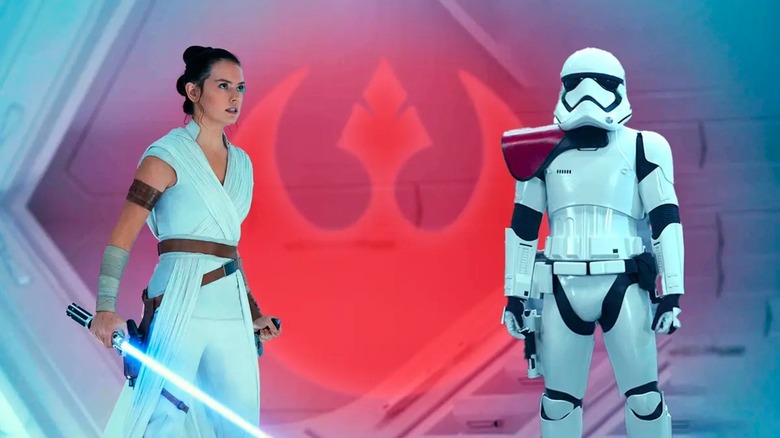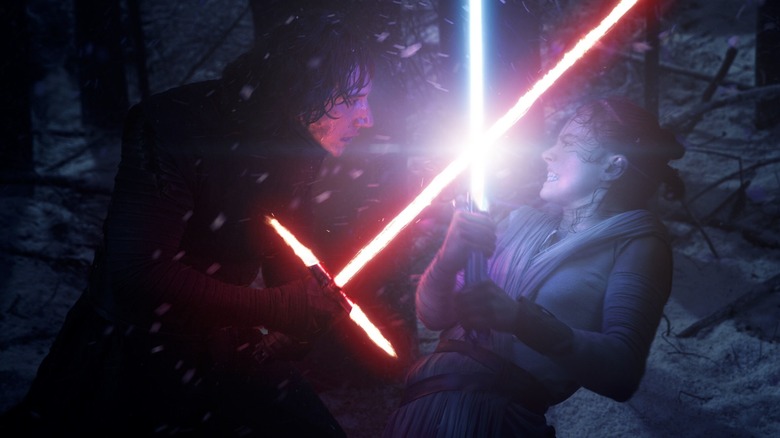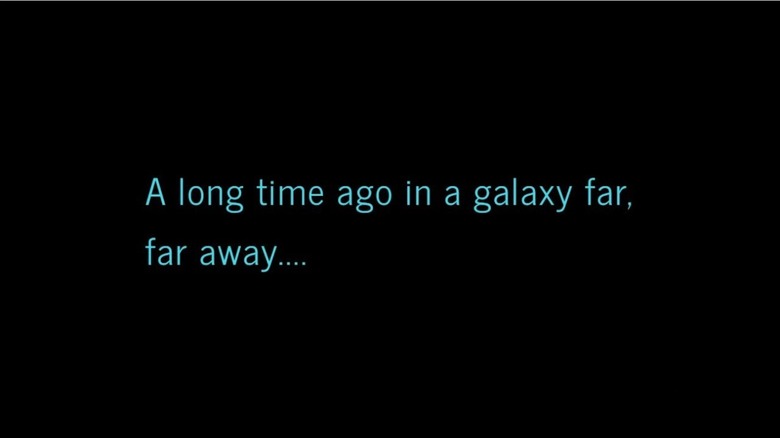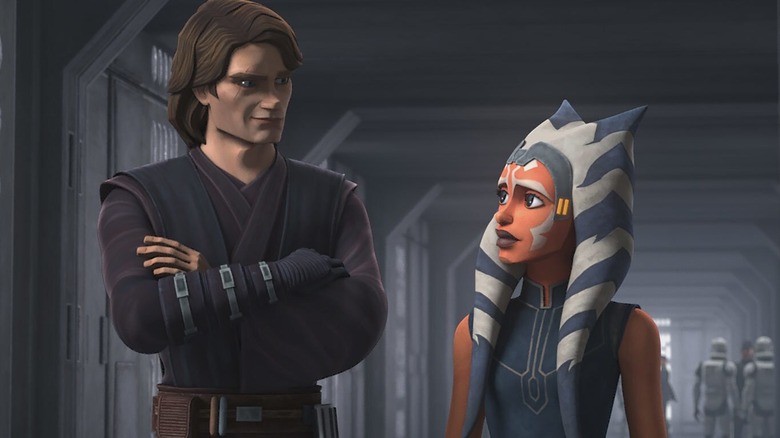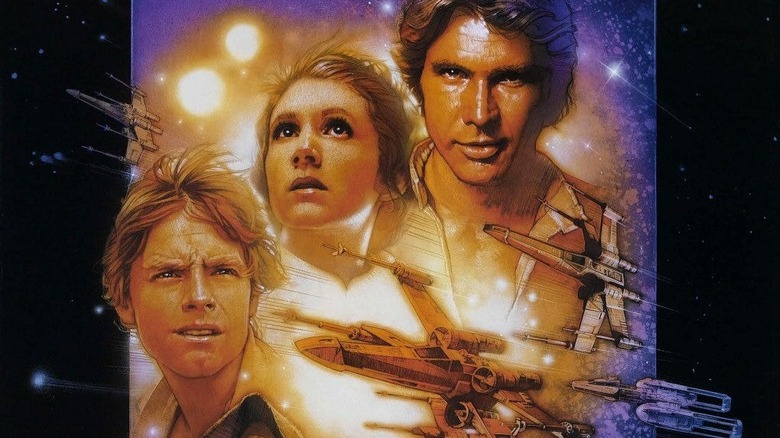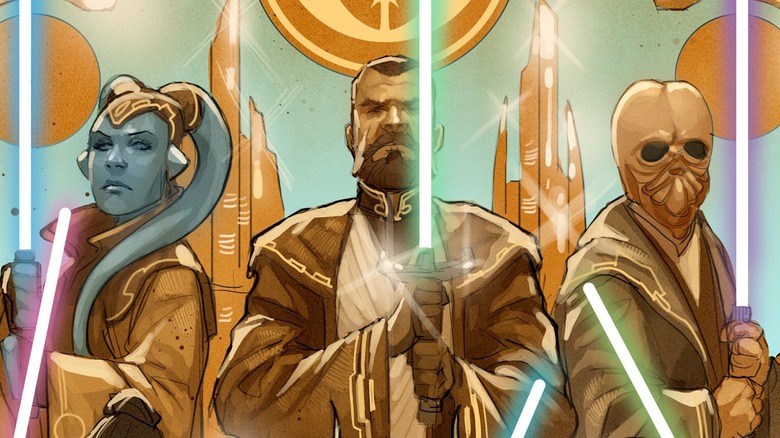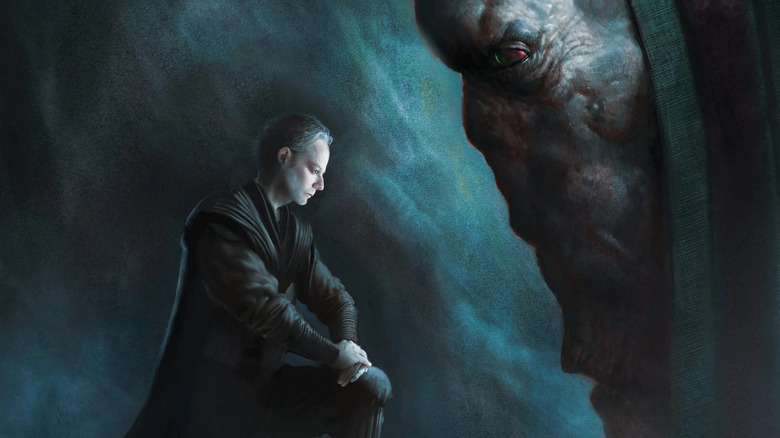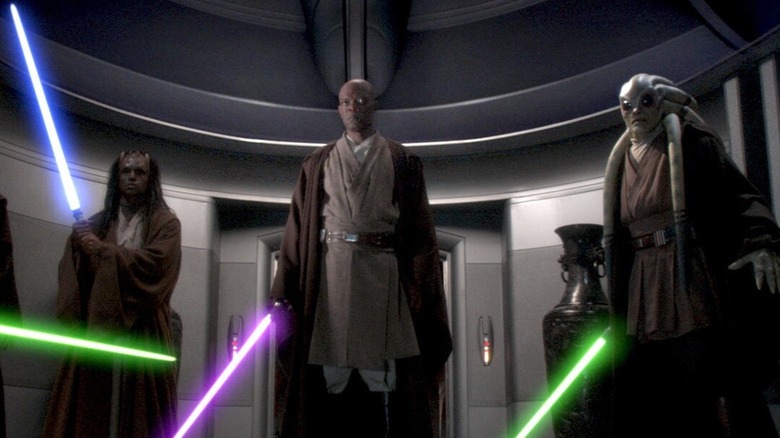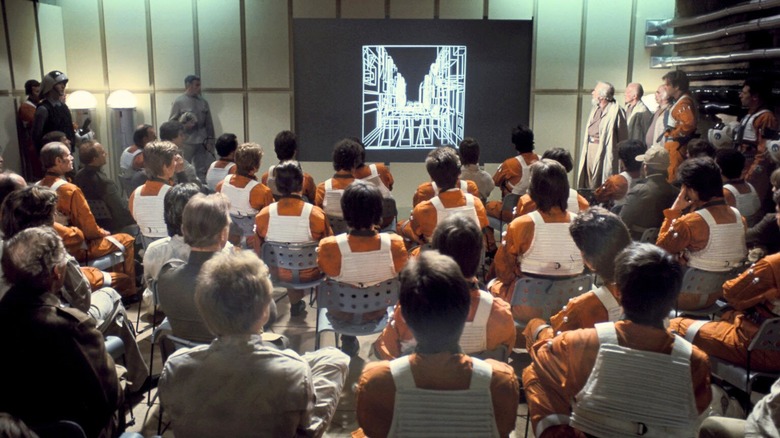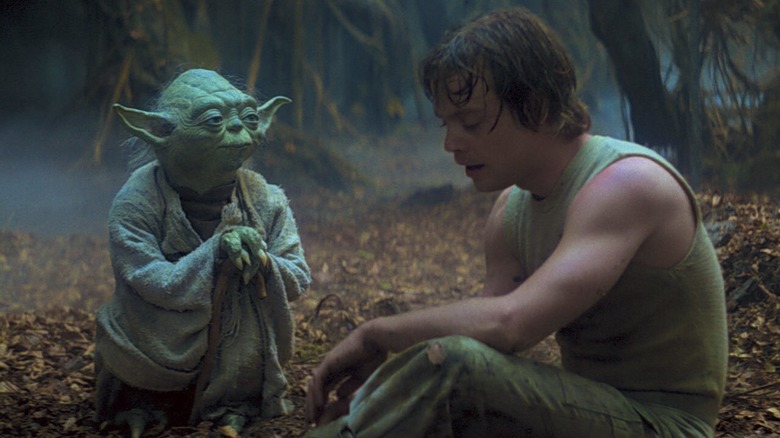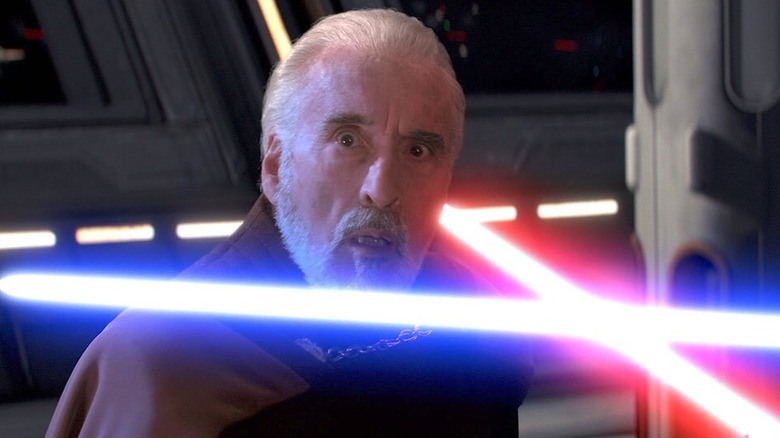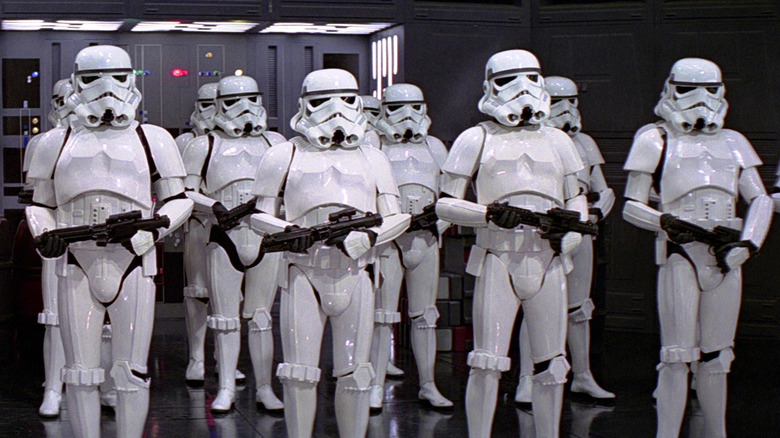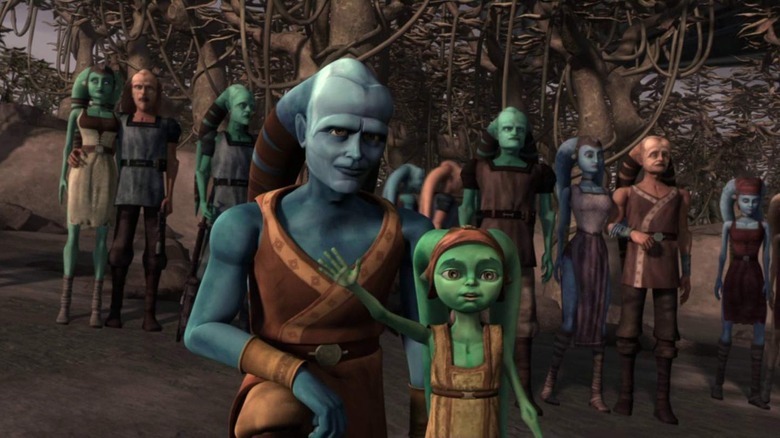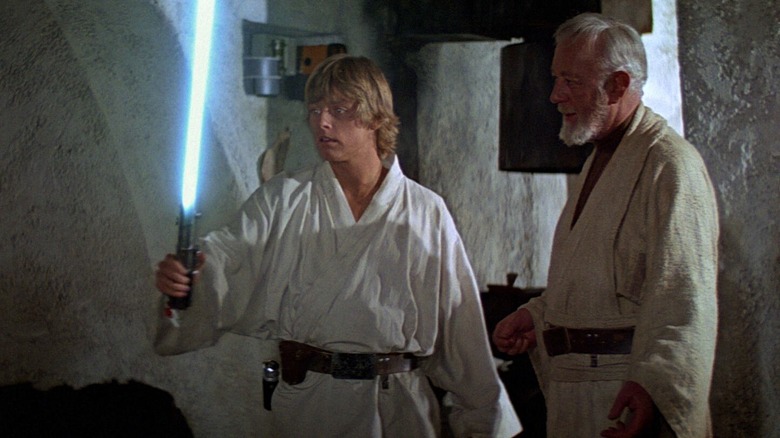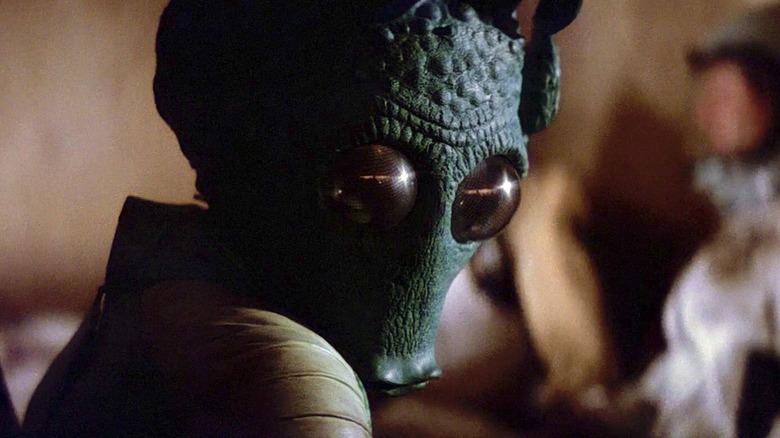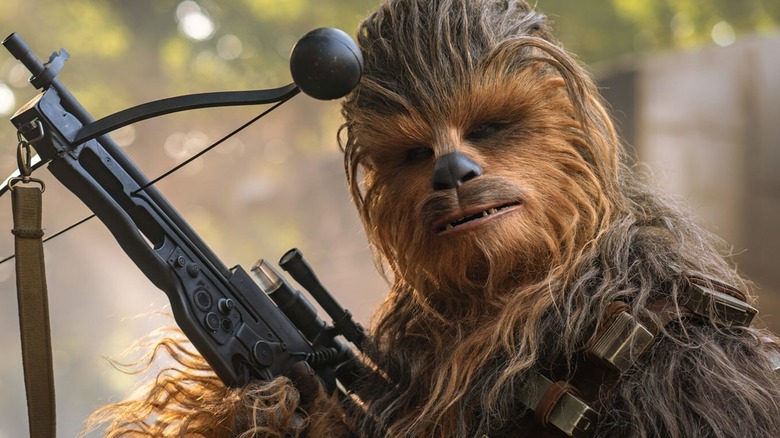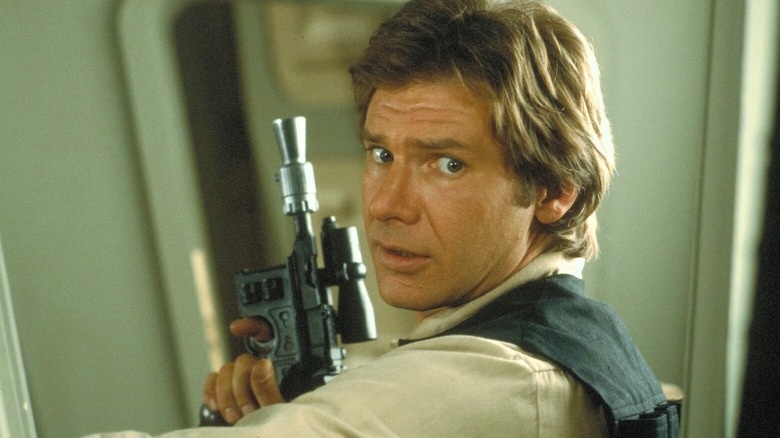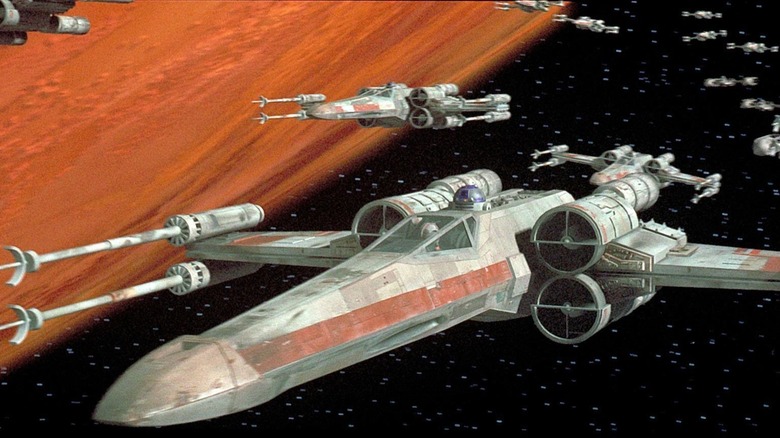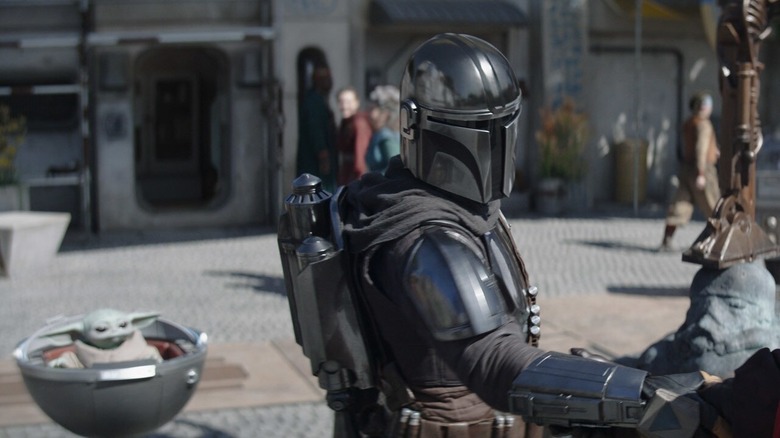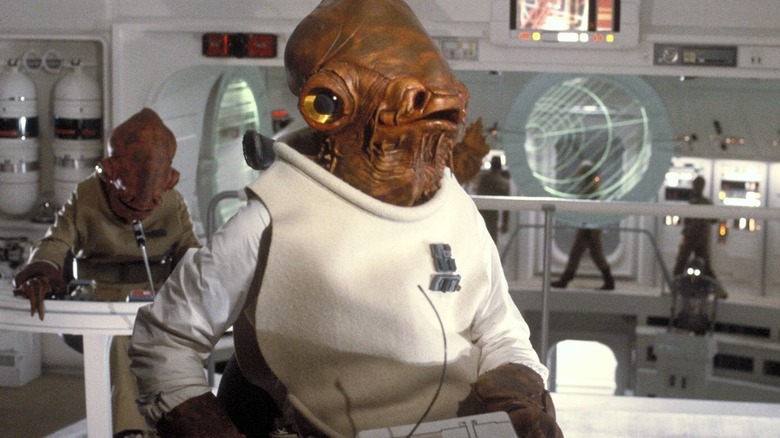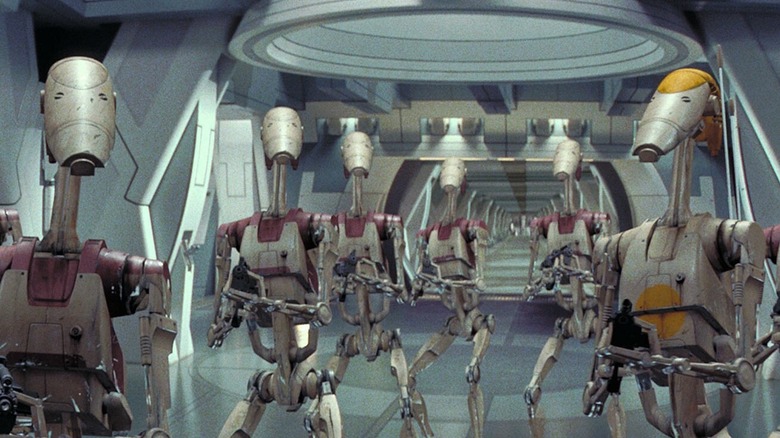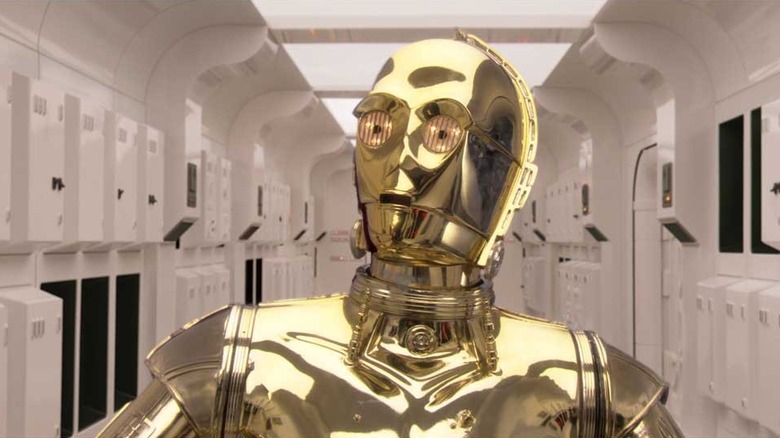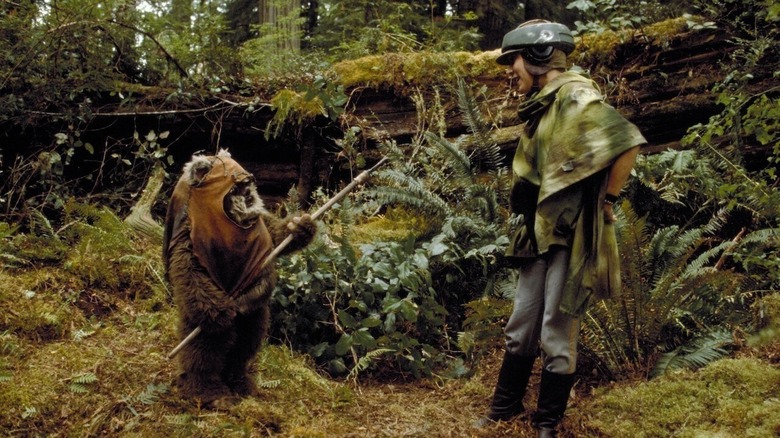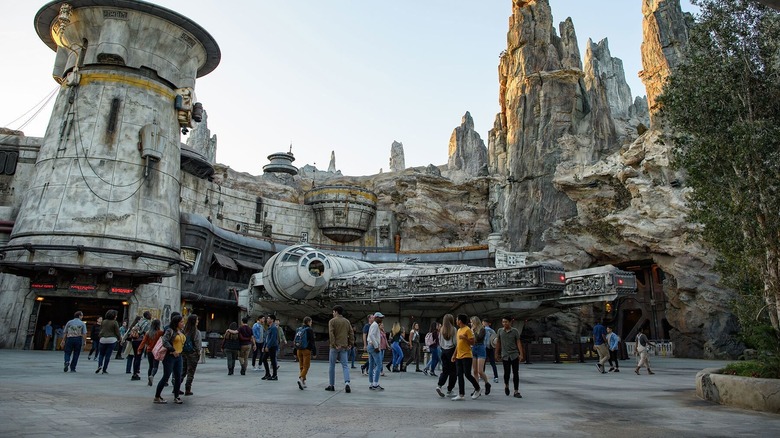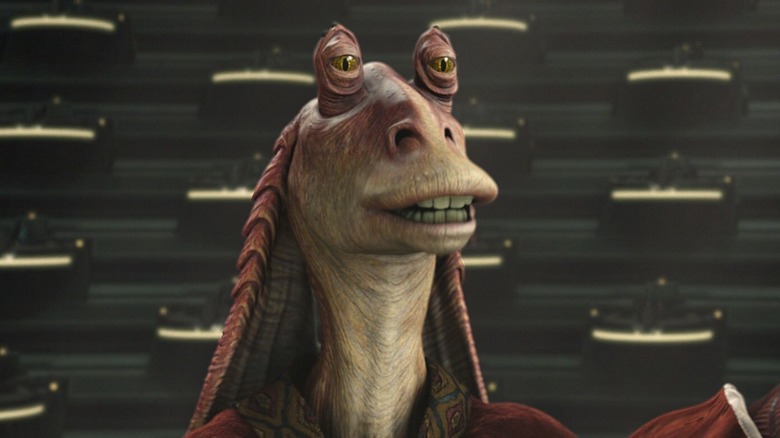Should You Capitalize Stormtroopers, Jedi, Or Rebel Alliance? A Star Wars Writing Style Guide
The "Star Wars" galaxy is vast, to put it lightly. The franchise has been one of the biggest staples of pop culture for nearly 50 years now, dating back to George Lucas' original sci-fi classic in 1977. These days, it's a sprawling, multimedia empire that is an entire universe unto itself. That universe contains its own technology, species, planets, vehicles, and so much more. All of that comes with very specific language that has a fair amount of nuance worth understanding.
Is Endor a planet or a moon? Should you capitalize stormtrooper? What exactly is the Expanded Universe? We're going to go over all of that and so much in more in this handy dandy "Star Wars" style guide. From the proper spellings of common aliens to understanding the entire timeline, we're going to break it all down so you can better navigate a galaxy far, far away.
Who owns Star Wars?
"Star Wars" started life at 20th Century Fox, with the studio releasing the original trilogy and the prequels, which hailed from George Lucas. However, in 2012, Disney purchased Lucasfilm and got the rights to all of the films in the franchise. They also purchased most of Fox's media assets in 2019 via a massive, multi-billion-dollar deal. So, anything under the "Star Wars" umbrella is now credited to Disney and/or Lucasfilm. It can only be credited to 20th Century Fox if referring to the past. In the present, 20th Century Fox no longer exists, as it is now called 20th Century Studios.
The proper, full titles of all of the films
When George Lucas released his original sci-fi classic in theaters in 1977, it was simply titled "Star Wars." But things quickly evolved as it became a trilogy and then, eventually, an entire saga, with "A New Hope" later added to the title. The full titles of the saga films, as a result, contain both a Roman numeral and a subtitle in addition to "Star Wars." The spin-off films, on the other hand, don't have the Roman numeral to deal with. Here are all of the full titles of all of the films released in the franchise thus far:
"Star Wars: Episode I – The Phantom Menace"
"Star Wars: Episode II – Attack of the Clones"
"Star Wars: Episode III – Revenge of the Sith"
"Star Wars: Episode IV – A New Hope"
"Star Wars: Episode V – The Empire Strikes Back"
"Star Wars: Episode VI – Return of the Jedi"
"Star Wars: Episode VII – The Force Awakens"
"Star Wars: Episode VIII – The Last Jedi"
"Star Wars: Episode IX – The Rise of Skywalker"
"Star Wars: The Clone Wars"
"Rogue One: A Star Wars Story"
"Solo: A Star Wars Story"
It is perfectly acceptable to write "Star Wars: A New Hope" most of the time, but it is important to know which Roman numeral is associated with each film. It's also important that the episode numbers are always Roman numerals and never numbers. It is "Episode VII" and never "Episode 7." On second or third mentions, it is perfectly fine to refer to the films by either the Roman numeral or just the subtitle.
Clone Wars vs. The Clone Wars
When discussing "Clone Wars" as it relates to the animated projects in the "Star Wars" franchise, there is a small but important distinction that needs to be made. In 2003, a series of largely 2D animated shorts produced by Genndy Tartakovsky titled "Star Wars: Clone Wars" aired on Cartoon Network. These shorts were eventually collected on DVD. Later, in 2008, Dave Filoni directed "Star Wars: The Clone Wars," a CGI animated feature that would set up an animated series of the same name, which ultimately ran for seven seasons.
The '03 shorts should always be referred to as "Clone Wars" without a "The," while the '08 movie and the show that followed should be referred to as "The Clone Wars." It is important to distinguish when discussing the '08 movie versus the TV show, as they both have the exact same title. Unfortunately, the titles all pretty much run together, but the projects are all quite different.
The original Star Wars trilogy vs. the 1997 Special Editions
The original "Star Wars" trilogy was released between 1977 and 1983, with "A New Hope" hitting theaters in '77, "The Empire Strikes Back" following in '80, and "Return of the Jedi" rounding it out in '83. In 1997, George Lucas went back and altered the original films, adding new scenes and changing certain elements, such as enhancing some of the visual effects. These were theatrically released between January and March of '97, and officially billed as the "Star Wars Trilogy Special Edition." The re-releases were a gigantic box office success, building off the 20th anniversary of the original film.
Ever since '97, these altered versions of the films are what have been made available to the public, with only outdated forms of physical media, such as VHS and Laserdisc, containing the unaltered original releases. The distinctions between the original theatrical cuts and the '97 re-releases are often important, such as Han Solo shooting Greedo first in "A New Hope" in the original cut, which was changed to have Greedo shooting at Han as well in the '97 re-release. The original cuts are not commercially available and there is no indication that they ever will be again.
The meaning of BBY and ABY
The timeline of the "Star Wars" galaxy is vast, containing several different eras, from the Old Republic thousands of years back in the past, to the Rise of the First Order, which we witnessed in the sequel trilogy. To understand an event's place on the timeline, a generally accepted measurement is BBY and ABY. This means "before the Battle of Yavin" or "after the Battle of Yavin." That battle is the climactic showdown at the end of "A New Hope" and, since that was the first film to hit theaters, it is used as the anchor point of the timeline.
This will often be used when referencing a show, movie, or event on the timeline. For example, the events of the animated series "Star Wars Rebels" take place between 5 BBY and 1 BBY, as the show documents the formation of the Rebellion in the lead-up to the events of the original trilogy. Or, we could look at "The Mandalorian," which kicks off its first season around 7 ABY, as it's set a handful of years after "Return of the Jedi."
The expanded universe: legends vs. canon
For nearly as long as "Star Wars" has been a part of popular culture, extensions of the franchise in other media, such as books, video games, and comics, have been produced to offer fans more to enjoy. Before Disney purchased Lucasfilm in 2012, this was all known as the Expanded Universe. Books such as the "Heir to the Empire" trilogy or "Star Wars: Plagueis" are part of this corner of the franchise. However, after the purchase, Disney made the ruling in 2014 that everything that had been produced prior to that time outside of the films and "The Clone Wars" animated series would be known as Legends. This material is no longer considered canon within the franchise.
It is important to understand that, when referring to the Expanded Universe, that only includes works produced prior to 2012 outside of the theatrically released films or "The Clone Wars." It is not correct to talk about a newer, canon novel, like "Thrawn: Alliances," for example, as part of the "Star Wars" Expanded Universe. Yes, these novels, comics, and games do expand the scope of the franchise, but they are part of the new, Disney-approved canon. Anything before the change is now officially considered Legends by Lucasfilm, but Expanded Universe is also acceptable nomenclature. Distinctions with this material should always be clear as to not confuse what is or is not canon.
Jedi and Sith
Jedi is the word to describe the order of Force-wielding protectors who were part of the Jedi Order and were the guardians of peace in the Galactic Republic. The Sith, meanwhile, are the counterpoint to the Jedi who wield the dark side and seek to amass power at all costs. Both Jedi and Sith should always be capitalized, and both words are also the plural forms of the respective orders as well. So it is Jedi, not "Jedis," and Sith, not "Siths."
Rebel Alliance and the Empire
The Rebel Alliance is the name of the group that stood up against the Galactic Empire, led by Emperor Palpatine, during the events of the original "Star Wars" trilogy. The Rebel Alliance is often referred to as the Rebellion, while the Galactic Empire is often referred to as simply the Empire. Both the full, proper names, as well as Rebellion and Empire, should always be capitalized. There's also the matter of referring to something as Imperial, such as an Imperial Star Destroyer. Imperial should always be capitalized, but certain words that follow may not be, like Imperial starfleet, as "starfleet" is not part of a proper title. But proper ship titles, for example, such as Star Destroyer, would be capitalized.
Shorthand names such as referring to members of the group as "rebels" or "rebel scum" would not be capitalized as that is not a proper title within the universe. But when it is part of a title, such as the show "Star Wars Rebels," it would be capitalized. The key thing is making sure that proper designations within these two organizations are distinguished and capitalized, while everything else is not.
The Force
The Force is officially defined by StarWars.com as "a mysterious energy field created by life that binds the galaxy together." While all living beings in the galaxy are connected to the Force, Jedi and Sith are able to tap into it, giving them their powers, such as levitating objects or mind manipulation. The word "Force" when referencing this energy filed in the galaxy is always capitalized but "the" preceding it is not. So it is "the Force" and not "The Force."
Dark side and light side
When talking about the Force, there is often accompanying talk about the "light side" or "dark side." The light side is generally associated with the Jedi, while the dark side is mostly associated with the Sith, though there is some gray area, such as with a gray Jedi, for example. In both cases, they are just descriptors and not proper titles, so they should not be capitalized.
Stormtroopers
Stormtroopers are the white-armored military troops employed by the Empire during the events of the original "Star Wars" trilogy and, later, by the First Order during the events of the sequel trilogy, beginning with "Star Wars: The Force Awakens." Though they are the main force in the Empire's military, stormtrooper is actually not capitalized. There are also several special units as offshoots of the stormtroopers, including scout troopers or snowtroopers. These are also not capitalized. When referring to them as Imperial stormtroopers, Imperial would be capitalized but stormtroopers would not.
Alien species
When writing about various alien species in the "Star Wars" galaxy, it can get a little tricky — there is some nuance to how it's all stylized. Sentient alien species are capitalized, such as Ewoks, for example, whereas semi-sentient species, such as rancor, are not capitalized. Twi'leks are very human-like, so in instances like that, it's not hard to figure out whether or not the species needs to be in caps. Then we have something like a Loth-cat, named after its native planet of Lothal. In that case, Loth is capitalized because it is in reference to the planet, even though the animals are not humanoid. If ever in doubt, check the official database entry for the species in question on StarWars.com.
Lightsaber
A lightsaber is the weapon of choice for Force-wielding beings in the galaxy, particularly the Jedi and the Sith. It is composed of a hilt that emits a solid beam of light, capable of deflecting blaster bolts, melting through steel doors, and much more. They are powered by a kyber crystal, which is a mineral that is attuned to the Force. Lightsaber is not capitalized as it as a type of weapon, like saying sword, for example. But Excalibur is the name of a specific sword. So, if there were a lightsaber with a given name, that would be capitalized.
Maclunkey
For those who may not be hardcore "Star Wars" fans, this may sound like a joke. In some ways, maybe it is. But Maclunkey is very much a real word from the franchise, and it rose to prominence in 2019 when the original trilogy was released on Disney+. Fans noticed that the scene where Han shoots the bounty hunter Greedo had been edited once again. This time, before his death, Greedo shouts the word "Maclunkey" before being cooked by Han's blaster.
Most fans weren't even aware of this word before 2019 but, if it ever comes up, this re-edited version of the famed scene from "A New Hope" is what is being referenced. As for what the word means? That has not been formally defined by the folks at Lucasfilm, but /Film's own Bryan Young did some digging around that time. Per Collider, in "The Phantom Menace," the podracer Sebulba appears to say the line to Anakin Skywalker. Translated from Sebulba's language (which is Huttese), it means "This'll be the end of you." That would seem to make sense in the context of the scene in question.
More than anything, this is a punchline that probably shouldn't be taken seriously.
Wookiee
Wookiees are one of the most recognizable alien species in the "Star Wars" galaxy, with Han Solo's trusty companion Chewbacca belonging to the powerful race of shaggy, tall beings. It is also one of the most commonly misspelled words in the franchise, as it is "Wookiee" and not "Wookie." It is also one of the alien species that is capitalized.
Weapon names and classifications
There are many, many different sorts of weapons in the "Star Wars" galaxy — far too many to name here. But the important thing to remember is that there are specific names for specific weapons, and there are broad classifications for types of weapons. For example, Han Solo's trusty blaster is a DL-44. So the name, DL-44 is spelled in caps. But as for its class of weapon, it's a blaster pistol. This could apply to a range of weapons in the universe, such as Rey's NN-13 blaster in "The Force Awakens." Stormtroopers, as another example, typically use an EM-11, which is a medium blaster rifle.
Ship classes versus proper ship names
Like weapons, there are a great many ships within "Star Wars." But there is a distinction between classes of ships and specific ship names. Ship classes, such as an X-wing or a TIE fighter, are not capitalized beyond the identifying letters. But a specific class of ship under a given category, such as a TIE Interceptor, for example, would be capitalized. An Imperial Star Destroyer is a specific class of ship, but it is a type of capital cruiser.
Aside from broader classifications, there are ships that have specific names, such as the Millennium Falcon. That is a singular name given to Han Solo's treasured ship, which is a modified Corellian light freighter. Corellian, in this case, is capitalized because it is in reference to the planet Corellia, but the rest of the ship classification is not.
The language of Star Wars
There are many languages in the "Star Wars" galaxy, such as Gunganese, which is spoken by the Gungans, which is the alien race that Jar Jar Binks belongs to. But many characters in the galaxy speak what we might refer to as English because, in our world, it is English. But it's important to know that this language has a name in the "Star Wars" universe: Galactic Basic, often shortened to simply Basic. So, when referring to the language a character is speaking, it should be stated as Galactic Basic or Basic, and not English.
Ranks and titles
When it comes to ranks and titles in the galaxy, the rank is always capitalized when it precedes a name. For example, it would be appropriate to say Admiral Ackbar or General Madine. As an example in the Imperial ranks, one would say Grand Admiral Thrawn or Grand Moff Tarkin. However, the ranks are not capitalized when not directly connected to the individual. If one were to say that Gial Ackbar served as an admiral in the Rebel Alliance, the rank would not be capitalized.
Droid names
Droid names in the "Star Wars" universe are very similar to weapon or ship names. There are broader classifications of droids, such as battle droids (the ones used by the Separatists in "The Phantom Menace"), or an astromech, like R2-D2. But the type of droid — or the word droid itself for that matter — is generally not capitalized. But a specific model of the droid, such as the B1 battle droid or the 2-1B medical droid, would be stylized in caps.
C-3PO, the right way
C-3PO is a protocol droid who is one of the most enduring characters in all of "Star Wars." Played by Anthony Daniels for more than 40 years, the droid has been a part of the franchise from the very beginning. A simple but common mistake is the spelling of the name — people will frequently use a zero as opposed to an O at the end. But the correct spelling is with the letter O and not the number 0, so it is C-3PO, human-cyborg relations.
Endor - is it a moon or a planet?
Endor was first introduced in "Return of the Jedi" and was an important location in the film, as the Empire had set up a shield generator for the Death Star there. It is also home to the Ewoks and was prominently featured in the made-for-TV movies "Caravan of Courage: An Ewok Adventure" and "Ewoks: The Battle for Endor." But because of the way the planet was first introduced, there has been some confusion as to whether Endor is a planet or a moon. Technically, it's both.
Endor is a planet, but not one that was visited in "Return of the Jedi." Rather, the Rebellion visits the forest moon of Endor, which is one of the inhabited moons circling the larger planet. But the moon itself is often referred to as Endor as well. Both the planet and the moon can be referred to as such, but since the forest moon is more well-known, it is generally assumed that when Endor is brought up, that is what is being discussed. If one is discussing the actual planet that the moon orbits, it should be made clear.
Star Wars: Galaxy's Edge
"Star Wars: Galaxy's Edge" is the name of the theme park land at both Disneyland and Walt Disney World. The area is presented as though it is in-universe and takes place in a place called Black Spire Outpost, which is located on the planet Batuu. This planet has since been explored in the expanded universe, appearing in several novels and comics.
Since "Galaxy's Edge" is very much part of the franchise, it should be referred to by its proper name. It shouldn't be referred to as "Star Wars Land," for example, which some fans might use as shorthand to describe it. There was also Disney's short-lived "Star Wars"-themed cruise-like attraction, the "Star Wars: Galactic Starcruiser," but that is being shut down after opening in March of 2022. It, similarly, was treated as an in-universe experience, with the whole thing taking place on a ship called the Halcyon.
Pay attention to hyphens
Many words within the "Star Wars" lexicon utilize hyphens. The problem is that some words that feel like they would use a hyphen don't, and others that don't feel like they would have one do. R2-D2 uses a hyphen, as many droid names often do. But Jar Jar Binks does not, so it should never be written as Jar-Jar. Similarly, Midi-Chlorians, the Force-sensitive organisms that reside in certain beings, is spelled with a hyphen. If there is ever a doubt as to whether or not a word contains a hyphen, check out the database entry for it on StarWars.com.
